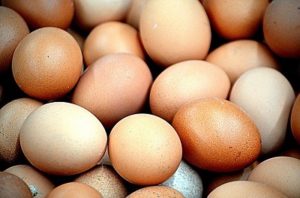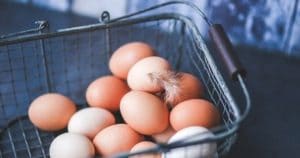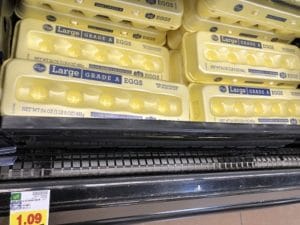
What is a Cage-Free Egg?
If you’re not familiar with the term “cage-free,” just look at the egg section at your grocery store. The good news is that cage-free is more than a marketing term; it is a defined term that has specific standards that must be met by egg producers, with the U.S. Department of Agriculture (USDA) regulating the label. Cage-free guidelines mandate eggs must be laid by hens raised in indoor floor operations that are free to roam in a building, room or open area and have unlimited access to food and water as well as nesting space and perching space. The access to the outdoors is optional whereas free range hens must have access to the outdoors.1 The USDA Agriculture Marketing Service (AMS) verifies cage-free claims for shell eggs by visiting producers twice each year to ensure that eggs are in fact coming from a cage-free flock.2 In contrast, conventional eggs are laid by hens raised in climate-controlled barns but within cages that keep them protected from other chickens. They have access to water and feed within their defined space.
The Current Reality
We all care about where our food comes from and how it’s produced. As someone who grew up with cows and chickens, I understand the importance of animal welfare, but there are times, if decisions are made without understanding the total situation, unintended consequences can occur.
The term cage-free actually describes the hen house we had on our family farm with 20 to 30 hens that my mother raised annually (I was the egg collector but not the biggest fan). We didn’t allow them to roam outside as they are not the tidiest animal and can fall prey to nature around them (and we had spent several years repairing yards and pastures from the previous owner’s roaming chickens).

The Financial Implications
The United Egg Producers (UEP) estimates that based on current state laws, 85 million birds will need to be switched over to cage-free systems within the next three to five years, and that’s only the beginning. Based on current retail and food companies’ commitment to cage-free eggs, a total of 225 million layers in the cage-free system will be needed, which is quite a challenge considering approximately 85% of eggs in retail stores are conventional.5 During the recent 2020 Poultry Science Association Virtual Annual Meeting, UEP president Chad Gregory stated that requirement “will cost egg farmers and egg companies between 10 and 11 billion dollars (or about $40 per bird to build the necessary infrastructure) … and they have less than five years to do that.” He continues, “I have said in many of my presentations the last couple years that the amount of birds that need to be switched to cage-free, the cost to do it, and the amount of time they have to do it in is financially and logistically impossible to achieve.”5
Dr. Jacqueline Jacob, University of Kentucky poultry specialist agrees. “It costs more to produce a cage-free egg. In order to go all cage-free within the next 5 years, investments need to be made now. The problem is cages are still relatively new in most of the facilities and banks don’t necessarily want to lend money when the cages have not completed their life.” Dr. Jacob also notes there are actually more cage-free eggs on the market now but are not being sold as such because companies calling for cage-free are not willing to pay the extra for them until they have to in 2025.
Are Cage-Free Eggs Sustainable?
In 2015, the Coalition for Sustainable Egg Production assessed five areas of sustainability — Animal Health and Well-Being, Food Safety and Quality, Environmental Impact, Worker Health and Safety, and Food Affordability — in three different housing systems, two cage-free and one conventional. Animal welfare related to chronic stress of the bird was not evident in any of the systems and egg quality was consistent. However, the highest environmental microbial levels were found in the cage-free systems due to litter and laying of eggs on floor pads.6

The Consumers’ Bottom Line
Consumers have to decide what’s important. Is the price associated with the type of production worth the value? Research studies show the merits and challenges of each system without a clear frontrunner when it comes to environmental impact and sustainability. The quality and nutritional content of the egg is the same regardless of the housing system. The chicken’s diet may alter the omega-3 composition of the egg but how the egg is produced is not a factor.

Simple solutions don’t usually exist and often come with unintended consequences. This is one food purchase where we truly are choosing the chicken or the egg. For me, I choose the egg.
References:
1. These Eggs or Those Eggs? Animal Agriculture Alliance, Emily Solis, April 4, 2018.
2. “USDA Graded Cage-Free Eggs: All They’re Cracked Up To Be,” U.S. Department of Agriculture, Craig A. Morris, February 21, 2017.
3. “Impact of Free-Range Poultry Production Systems on Animal Health, Human Health, Productivity, Environment, Food Safety, and Animal Welfare Issues,” CAST Issue Papers, IP61, July 2018.
4. “Colorado lawmakers: We Didn’t Want Cage-Free Egg Law,” WATTAgNet.com, Roy Graber, July 7, 2020.
5. “Cage-Free Transition Financially and Logistically Impossible,” WATTAgNet.com, Deven King, July 29, 2020.
6. “Cage-Free Eggs: A PR Battle or Concern for Animal Welfare?” Animal Agriculture Alliance, Casey Kinler, March 11, 2016.
